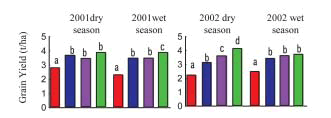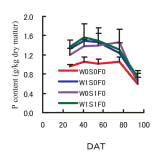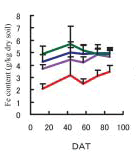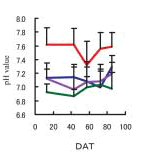Growth suppression of rice caused by water drainage during fallow season in the tropics
Description
[Objectives]
Soil erosion caused by precipitation is a kind of land degradation commonly appeared in the sloping lands of humid areas. In this study, we attempted to estimate the hazardous conditions of soil erosion by using geographic information systems (GIS). The study site used for this project was Langensari Village located in the Lembang Sub-District, Bandung District, West Java Province in Indonesia, where temperate vegetable fields were spread widely over the sloping highlands. Fig. 1 shows a typical scene of vegetable field in the site. We employed the Universal Soil Loss Equation (USLE) to estimate soil loss in the site. The objectives were 1) to develop a method to obtain factors used in the USLE from various geographic data including remote sensing data, and 2) to demonstrate the applicability of the system to land use planning.
[Results]
Research was conducted on four subplots within the research site. At the W0 plot, the field was not supplied with irrigation water, while at W1 plot, the field was flooded throughout the fallow season. In S0 subplot, all rice straw was removed from the field after harvesting crops of the previous season, whereas in S1 subplot, rice straw was left on the field, and was incorporated into the soil one month before transplanting. In the latter field, 50 kg/ha of nitrogen (N) was applied irrespective of season; neither phosphorus (P) nor potassium (K) was applied. The growth suppression that was observed during both the wet and dry seasons became more prominent in the W0S0 plots (Fig. 1). This tendency was same as those in 2001 wet season (WS), 2002 dry season (DS), and 2002WS (data not shown). The rice yields in the W0S0 plot were significantly lower than those of the other plots indicating that growth suppression during the early stages of cultivation at the W0S0 plots lead to the decrease in yield of rice (Fig. 2). Phosphorus content in the growth-suppressed rice (W0S0 plot) was lower than that of the rice not subjected to growth suppression (Fig. 3a) suggesting that suppression of rice growth was caused by phosphorus deficiency in the plants. From the data for the growth-suppressed plots, the P deficiency of growthinhibited rice was associated with a small amount of available P due to the low Fe(II) content in the soil (Fig. 3b) and/or the high soil pH (Fig. 3c).
Figure, table
-
Fig. 1. Changes in dry weight (2001 wet season).
Symbols with differing letters denote significant differences at the 5% level. (Same as below) -
Fig. 2. Grain yield.
The colors for each plot are as given in the legend for Fig. 1. -
Fig. 3a. Changes in P content in leaves.
Vertical bars indicate standard deviation (same as above). -
Fig. 3b. Changes in Fe (II) content in soil. -
Fig. 3c. Changes in pH levels.
- Affiliation
-
Japan International Research Center for Agricultural Sciences Crop Production and Environment Division
- Classification
-
Technical A
- Term of research
-
FY2003 (FY2000-2004)
- Responsible researcher
-
NOZOE Takuhito ( Crop Production and Environment Division )
- ほか
- Japanese PDF
-
2003_11_A3_ja.pdf2.69 MB
- English PDF
-
2003_11_A4_en.pdf71.06 KB





